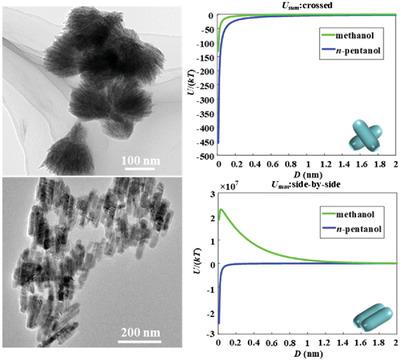当前位置:
X-MOL 学术
›
Cryst. Res. Technol.
›
论文详情
Our official English website, www.x-mol.net, welcomes your
feedback! (Note: you will need to create a separate account there.)
Formation Mechanism of ZnO Nanorod Superstructures in Different Solvents
Crystal Research and Technology ( IF 1.5 ) Pub Date : 2019-11-22 , DOI: 10.1002/crat.201900167 Mingli Yue 1 , Lei Yang 2 , Ying Hou 1 , Jiaqi Zhu 2 , Ming Yang 1
Crystal Research and Technology ( IF 1.5 ) Pub Date : 2019-11-22 , DOI: 10.1002/crat.201900167 Mingli Yue 1 , Lei Yang 2 , Ying Hou 1 , Jiaqi Zhu 2 , Ming Yang 1
Affiliation

|
Hierarchical superstructures consisting of nanoscale building blocks show great potential in achieving configurable properties. In this work, two patterns of ZnO nanorod superstructures are obtained directly by thermal decomposition of zinc acetylacetonate in different solvents. Namely, fan‐shaped structures are obtained in methanol, whereas side‐by‐side assembly is achieved in n‐pentanol. Time‐dependent observations indicate the formation of quasi‐spherical particles at the beginning of the reaction, which later transform into different superstructures depending on the types of solvents. The selective formation of superstructures is rationalized based on the calculation of interaction potentials between two nanorods with either crossed or side‐by‐side spatial organizations. The results reveal the significant role of solvents in affecting electrostatic repulsion, which may compete with attractive van der Waals forces leading to the favored superstructures.
中文翻译:

不同溶剂中ZnO纳米棒超结构的形成机理
由纳米级构建块组成的分层超结构在实现可配置属性方面显示出巨大潜力。在这项工作中,通过在不同溶剂中热分解乙酰丙酮锌可以直接获得两种形式的ZnO纳米棒超结构。即,在甲醇中得到的扇形结构,而并排侧组件在实现Ñ戊醇。随时间变化的观察表明,在反应开始时形成了准球形颗粒,随后根据溶剂的类型转变成不同的上层结构。基于计算具有交叉或并排空间组织的两个纳米棒之间的相互作用势,可以合理地选择上层建筑的形成。结果表明,溶剂在影响静电排斥方面起着重要作用,它可能与引人注目的范德华力竞争,从而导致偏爱的上层建筑。
更新日期:2020-01-07
中文翻译:

不同溶剂中ZnO纳米棒超结构的形成机理
由纳米级构建块组成的分层超结构在实现可配置属性方面显示出巨大潜力。在这项工作中,通过在不同溶剂中热分解乙酰丙酮锌可以直接获得两种形式的ZnO纳米棒超结构。即,在甲醇中得到的扇形结构,而并排侧组件在实现Ñ戊醇。随时间变化的观察表明,在反应开始时形成了准球形颗粒,随后根据溶剂的类型转变成不同的上层结构。基于计算具有交叉或并排空间组织的两个纳米棒之间的相互作用势,可以合理地选择上层建筑的形成。结果表明,溶剂在影响静电排斥方面起着重要作用,它可能与引人注目的范德华力竞争,从而导致偏爱的上层建筑。











































 京公网安备 11010802027423号
京公网安备 11010802027423号